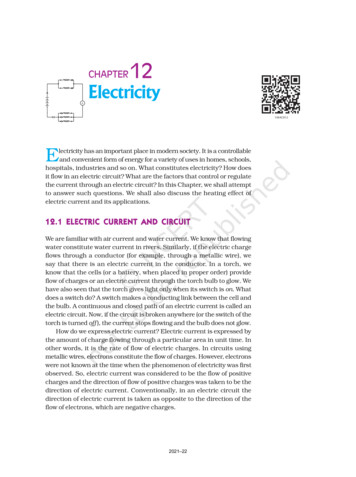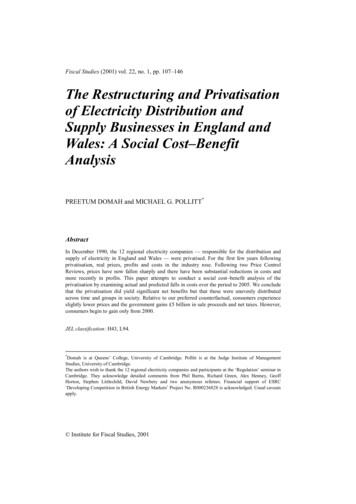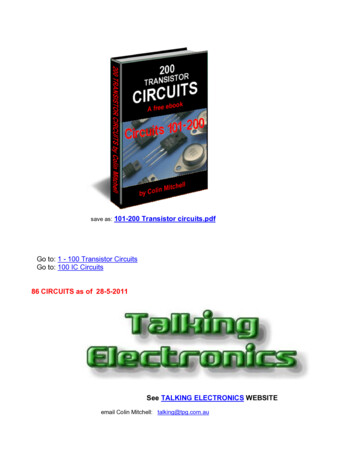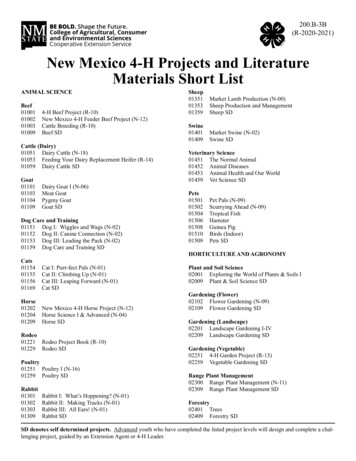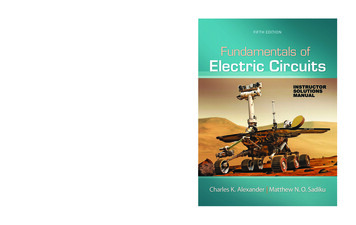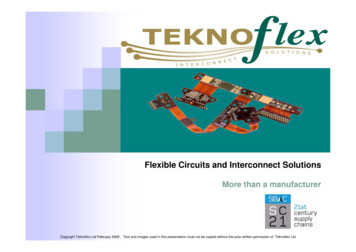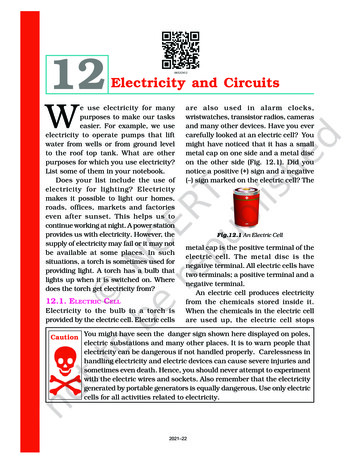
Transcription
12Electricity and CircuitsWe use electricity for manypurposes to make our taskseasier. For example, we useelectricity to operate pumps that liftwater from wells or from ground levelto the roof top tank. What are otherpurposes for which you use electricity?List some of them in your notebook.Does your list include the use ofelectricity for lighting? Electricitymakes it possible to light our homes,roads, offices, markets and factorieseven after sunset. This helps us tocontinue working at night. A power stationprovides us with electricity. However, thesupply of electricity may fail or it may notbe available at some places. In suchsituations, a torch is sometimes used forproviding light. A torch has a bulb thatlights up when it is switched on. Wheredoes the torch get electricity from?12.1. ELECTRIC CELLElectricity to the bulb in a torch isprovided by the electric cell. Electric cellsare also used in alarm clocks,wristwatches, transistor radios, camerasand many other devices. Have you evercarefully looked at an electric cell? Youmight have noticed that it has a smallmetal cap on one side and a metal discon the other side (Fig. 12.1). Did younotice a positive ( ) sign and a negative(–) sign marked on the electric cell? TheFig.12.1 An Electric Cellmetal cap is the positive terminal of theelectric cell. The metal disc is thenegative terminal. All electric cells havetwo terminals; a positive terminal and anegative terminal.An electric cell produces electricityfrom the chemicals stored inside it.When the chemicals in the electric cellare used up, the electric cell stopsdisplayed on poles,Caution You might have seen the danger sign shown hereelectric substations and many other places. It is to warn people thatelectricity can be dangerous if not handled properly. Carelessness inhandling electricity and electric devices can cause severe injuries andsometimes even death. Hence, you should never attempt to experimentwith the electric wires and sockets. Also remember that the electricitygenerated by portable generators is equally dangerous. Use only electriccells for all activities related to electricity.116SCIENCE2021–22
FilamentCaution: Never join the two terminalsof the electric cell without connectingthem through a switch and a devicelike a bulb. If you do so, the chemicalsin the electric cell get used up very fastand the cell stops working.Terminals(a)(b)Fig.12.2 (a) Torch bulb and (b) its inside viewproducing electricity. The electric cellthen has to be replaced with a new one.A torch bulb has an outer case ofglass that is fixed on a metallic base [Fig.12. 2 (a)]. What is inside the glass caseof the bulb?Activity 1Take a torch and look inside its bulb.You can also take out the bulb with thehelp of your teacher. What do younotice? Do you find a thin wire fixed inthe middle of the glass bulb [Fig. 12.2(b)]? Now switch the torch on andobserve which part of the bulb isglowing.The thin wire that gives off light iscalled the filament of the bulb. Thefilament is fixed to two thicker wires,which also provide support to it, asshown in Fig. 12.2 (b). One of these thickwires is connected to the metal case atthe base of the bulb [Fig. 12.2 (b)]. Theother thick wire is connected to themetal tip at the centre of the base. Thebase of the bulb and the metal tip of thebase are the two terminals of the bulb.These two terminals are fixed in such away that they do not touch each other.The electric bulbs used at home alsohave a similar design.Thus, both the electric cell and thebulb have two terminals each. Why dothey have these two terminals?12.2. A BULB CONNECTEDAN ELECTRIC CELLTOLet us try to make an electric bulb lightup using an electric cell. How do we dothat?Activity 2Take four lengths of electric wire withdifferently coloured plastic coverings.Remove a little of the plastic coveringfrom each length of wire at the ends.This would expose the metal wires atthe ends of each length. Fix the exposedparts of two wires to the cell and theother two of the bulb as shown inFig. 12.3 and Fig. 12.4.Fig.12.3 Electric cell with two wires attached to itELECTRICITY AND CIRCUITS1172021–22
Fig.12.4 Bulb connected to two wiresYou can stick the wires to the bulbwith the tape used by electricians. Userubber bands or tape to fix the wires tothe cell.Now, connect the wires fixed to thebulb with those attached to the cell insix different ways as have been shown inFig. 12.5 (a) to (f). For each arrangement,find out whether the bulb glows or not.(a)(d)Write 'Yes' or 'No' for each arrangementin your notebook.Now, carefully look at thearrangements in which the bulb glows.Compare these with those in which thebulb does not glow. Can you find thereason for the difference?Keep the tip of your pencil on thewire near one terminal of the electric cellfor the arrangment in Fig. 12.5 (a). Movethe pencil along the wire all the way tothe bulb. Now, from the other terminalof the bulb, move along the other wireconnected to the cell. Repeat thisexercise for all the other arrangementsin Fig. 12.5. Did the bulb glow for thearrangements in which you could notmove the pencil from one terminal tothe other?(b)(e)(c)(f)Fig.12.5 Different arrangements of electric cell and bulb118SCIENCE2021–22
12.3 AN ELECTRIC CIRCUITIn Activity 2 you connected one terminalof the electric cell to the other terminalthrough wires passing to and from theelectric bulb. Note that in thearrangements shown in Fig. 12. 5 (a)and (f), the two terminals of the electriccell were connected to two terminals ofthe bulb. Such an arrangement is anexample of an electric circuit. The electriccircuit provides a complete path forelectricity to pass (current to flow)between the two terminals of the electriccell. The bulb glows only when currentflows through the circuit.In an electric circuit, the direction ofcurrent is taken to be from the positiveto the negative terminal of the electriccell as shown in Fig.12.6. When theAn electric bulb may fuse due tomany reasons. One reason for a bulb tofuse is a break in its filament. A breakin the filament of an electric bulb meansa break in the path of the currentbetween the terminals of the electric cell.Therefore, a fused bulb does not lightup as no current passes through itsfilament.Can you now explain why the bulbdid not glow when you tried to do sowith the arrangements shown in Fig.12.5 (b), (c), (d) and (e)?Now we know how to make a bulblight up using an electric cell. Wouldyou like to make a torch for yourself?Activity 3Take a torch bulb and a piece of wire.Remove the plastic covering at the twoends of the wire as you did before. Wrapone end of a wire around the base of anelectric bulb as shown in Fig. 12.7. Fixthe other end of the wire to the negativeterminal of an electric cell with a rubberband. Now, bring the tip of the base ofthe bulb, that is, its other terminal incontact with the positive terminal of theFig.12.6 Direction of current in an electriccircuitterminals of the bulb are connected withthat of the electric cell by wires, thecurrent passes through the filament ofthe bulb. This makes the bulb glow.Sometimes an electric bulb does notglow even if it is connected to the cell.This may happen if the bulb has fused.Look at a fused bulb carefully. Is thefilament inside it intact?ELECTRICITY AND CIRCUITSFig. 12.7 A home-made torch1192021–22
a drawing pin into the ring at oneend of the safety pin and fix it on thethermo Col sheet as shown in Fig. 12.8.Make sure that the safety pin can berotated freely. Now, fix the other drawingpin on the thermo Col sheet in a waythat the free end of the safety pin cantouch it. The safety pin fixed in this waywould be your switch in this activity.Paheli has anotherarrangement of the celland the bulb. Will thetorch bulb glow inthe followingarrangement?cell. Does the bulb glow? Now move thebulb away from the terminal of theelectric cell. Does the bulb remainlighted? Is this not similar to what youdo when you switch your torch on oroff?12.4 ELECTRIC SWITCHFig 12.9 An electric circuit with a switchWe had an arrangement for switchingon or off our home made torch bymoving the base of the bulb away fromthe tip of the cell. This was a simpleswitch, but, not very easy to use. Wecan make another simple and easierswitch to use in our circuit.Activity 4You can make a switch using twodrawing pins, a safety pin (or a paperclip), two wires and a small sheet ofthermo Col or a wooden board. InsertNow, make a circuit by connectingan electric cell and a bulb with thisswitch as shown in Fig.12.9. Rotate thesafety pin so that its free end touchesthe other drawing pin. What do youobserve? Now, move the safety pin away.Does the bulb continue to glow?The safety pin covered the gapbetween the drawing pins whenyou made it touch two of them. Inthis position the switch is said to be 'on'(Fig. 12.10). Since the material of thesafety pin allows the current to passFig. 12.8 A simple switchFig. 12.10 A switch in ‘on’ position120SCIENCE2021–22
through it, the circuit was complete.Hence, the bulb glows.On the other hand, the bulb did notglow when the safety pin was not intouch with the other drawing pin. Thecircuit was not complete as there was agap between the two drawing pins. InBoojho has drawn the insideof the torch as in Fig. 12.11.When we close the switch,the circuit is completed andthe bulb glows. Can youdraw a red line on the figureindicating the complete circuit?Reflectorthis position, the switch is said to be'off' as in Fig. 12.9.A switch is a simple device that eitherbreaks the circuit or completes it. Theswitches used in lighting of electricbulbs and other devices in homes workon the same principle although theirdesigns are more complex.12.5 E LECTRIC C ONDUCTORSINSULATORSANDIn all our activities we have used metalwires to make a circuit. Suppose we usea cotton thread instead of a metal wireto make a circuit. Do you think that thebulb will light up in such a circuit?What materials can be used in electriccircuits so that the current can passthrough them? Let us find out.Activity 5Disconnect the switch from the electriccircuit you used for Activity 4. This wouldleave you with two free ends of wires asshown in Fig. 12.12 (a). Bring the freeends of the two wires close, to let themtouch each other. Does the bulb light up?You can now use this arrangement to testwhether any given material allows currentto pass through it or not.(a)Fig. 12.11 Inside view of a torch(b)Fig. 12.12 (a) A conduction tester (b) Testingwhether the bulb glows when the tester is incontact with a keyELECTRICITY AND CIRCUITS1212021–22
Collect samples of different types ofmaterials such as coins, cork, rubber,glass, keys, pins, plastic scale, woodenblock, aluminium foil, candle, sewingneedle, thermo Col, paper and pencillead. One by one bring the free ends ofthe wires of your tester in contact withtwo ends of the samples you havecollected [Fig. 12.12 (b)]. Make sure thatthe two wires do not touch each otherwhile you are doing so. Does the bulbglow in each case?Make a table in your notebooksimilar to Table.12.1, and record yourobservations.Table 12.1 Conductors and insulatorsObject used inplace of theswitchMaterialit ismade PlasticMatchstickWoodGlass bangleGlassIron nailMetalWhat do you find? The bulb does notglow when the free ends of the wires arein contact with some of the materials youhave tested. This means that thesematerials do not allow the electric currentto pass through them. On the other hand,some materials allow electric current topass through them, which is indicatedby the glowing bulb. Materials whichallow electric current to pass throughthem are conductors of electricity.Insulators do not allow electric currentto pass through them. With the help ofTable 12.1, name the materials that areconductors of electricity and also thosewhich are insulators.Conductors , ,Insulator , ,What do you conclude? Whichmaterials are conductors and which areinsulators? Recall the objects that wegrouped as those having lustre, inChapter 4. Are they the conductors? Itnow seems easy to understand whycopper, aluminum and other metals areused for making wires.Let us recall Activity 4 in which wemade an electric circuit with a switch(Fig.12.9). When the switch was in theopen position, were the two drawing pinsnot connected with each other throughthe thermo Col sheet? But, thermo Col,you may have found is an insulator.What about the air between the gap?Since the bulb does not glow when thereis only air in the gap between the drawingpins in your switch, it means that air isalso an insulator.Conductors and insulators areequally important for us. Switches,electrical plugs and sockets are made ofconductors. On the other hand, rubberand plastics are used for coveringelectrical wires, plug tops, switches andother parts of electrical appliances,which people might touch.122Caution: Your body is a conductor ofelectricity. Therefore, be careful whenyou handle an electrical appliance.SCIENCE2021–22
nElectric cell is a source of electricity.nAn electric cell has two terminals; one is called positive ( ve) while theother is negative (– ve).nAn electric bulb has a filament that is connected to its terminals.nAn electric bulb glows when electric current passes through it.nIn a closed electric circuit, the electric current passes from one terminal ofthe electric cell to the other terminal.nSwitch is a simple device that is used to either break the electric circuit orto complete it.nMaterials that allow electric current to pass through them are calledconductors.nMaterials that do not allow electric current to pass through them are calledinsulators.BulbConductorsElectric cellElectric circuit1.Fill in the blanks :(a) A device that is used to break an electric circuit is called .(b) An electric cell has terminals.2.Mark 'True' or 'False' for following statements:(a) Electric current can flow through metals.(b) Instead of metal wires, a jute string can beused to make a circuit.(c) Electric current can pass through a sheetof thermo Col.3.Explain why the bulb would not glow in thearrangement shown in Fig. 12.13.Fig. 12.13ELECTRICITY AND CIRCUITS1232021–22
4.Complete the drawing shown in Fig 12.14 toindicate where the free ends of the two wiresshould be joined to make the bulb glow.5.What is the purpose of using an electric switch?Name some electrical gadgets that have switchesbuilt into them.6.Would the bulb glow after completing the circuitshown in Fig. 12.14 if instead of safety pin weuse an eraser?7.Fig. 12.14Would the bulb glow in the circuit shown in Fig. 12.15?Fig. 12.158.Using the "conduction tester" on an object it was found that the bulb begins toglow. Is that object a conductor or an insulator? Explain.9.Why should an electrician use rubber gloves while repairing an electric switchat your home? Explain.10. The handles of the tools like screwdrivers and pliers used by electricians forrepair work usually have plastic or rubber covers on them. Can you explainwhy?SOME SUGGESTED ACTIVITIES1. Imagine there were no electric supply for a month. How would that affect yourday to day activities and others in your family? Present your imagination inthe form of a story or a play. If possible stage the play written by you or yourfriends in school.2. For your friends, you may set up a game "How steady is your hand?". You willneed a cell, an electric bulb, a metal key, two iron nails ( about 5 cm in length),about one and a half metre long thick metal wire (with its plastic insulationscraped off ) and few pieces of connecting wires. Fix two nails nearly one metreapart on a wooden board so that these can be used as a hook. Fix the wirebetween the nails after inserting it through the loop of the key. Connect oneend of this wire to a bulb and a cell. Connect the other terminal of the cell tothe key with a wire. Ask your friend to move the loop along the straight wirewithout touching it. Glowing of the bulb would indicate that the loop of the keyhas touched the wire.3. Read and find out about Alessandro Volta who invented the electric cell. Youmay also find out about Thomas Alva Edison who invented the electric bulb.124SCIENCE2021–22
electricity to pass (current to flow) between the two terminals of the electric cell. The bulb glows only when current flows through the circuit. In an electric circuit, the direction of current is taken to be from the positive to the negative terminal of the



